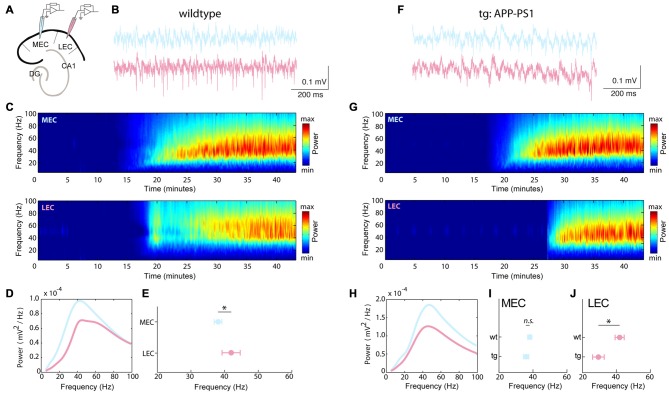Figure 1.
Frequency of in vitro gamma oscillations slow down in the lateral but not the medial entorhinal cortex (MEC) in the transgenic (tg) amyloid precursor protein (APP)-presenilin 1 (PS1) mice as early as 4–5 months. Gamma oscillations were evoked using kainate and stable recordings were established in both the MEC and lateral entorhinal cortex (LEC): (A–E) wild type (wt) and (F–H) tg APP-PS1. (A) Recording configurations for simultaneous gamma oscillation recordings in the MEC and LEC. (B) Local field potential recordings from MEC (blue) and LEC (pink) showing gamma oscillatory activity. (C) Spectrograms showing the frequency content of the signal (from the same experiment as in B). (D) Power spectra of the same experiment as in (B). (E) Peak frequency of gamma oscillations in the LEC and MEC (LEC: 42.00 ± 2.76 Hz; MEC: 38.14 ± 1.54 Hz, n = 21 recordings from seven wt animals; p = 0.0168). (F) Local field potential recordings from MEC (blue) and LEC (pink) showing gamma oscillatory activity in the tg APP-PS1 mice. (G) Spectrograms showing the frequency content of the signal (from the same experiment as in F). (H) Power spectra of the same experiment as in (F). (I,J) Peak frequency of gamma oscillations for (I) MEC wt and tg APP-PS1 animals show no significant differences (MEC wt: 38.14 ± 1.54 Hz; MEC tg: 36.00 ± 1.54 Hz, n = 21 MEC recordings from seven wt animals, 37 MEC recordings from 10 tg animals; p = 0.168). (J) LEC wt and tg APP-PS1 peak frequencies are significantly different (LEC wt: 42.00 ± 2.76 Hz; LEC tg: 29.54 ± 3.43 Hz, n = 21 LEC recordings from seven wt animals, 37 LEC recordings from 10 tg animals; p = 0.0107). n.s.–non significant, *p < 0.05, **p < 0.01.

